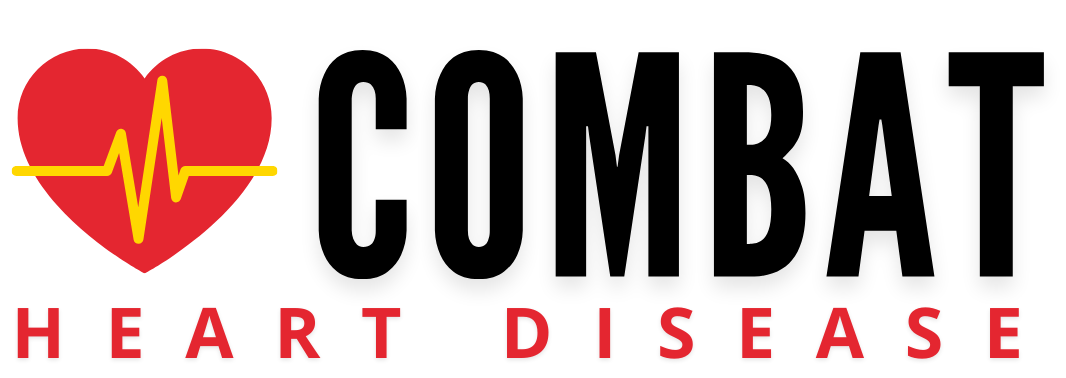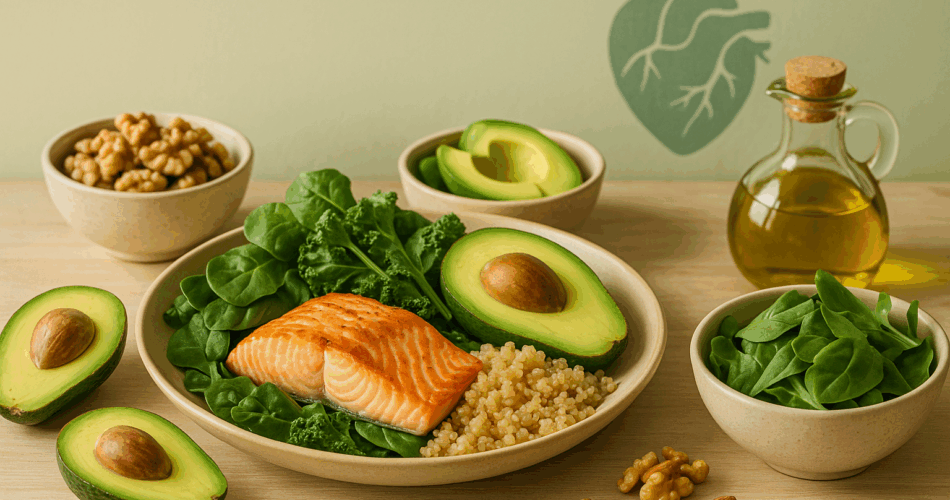Understanding Arterial Health (Quick Primer)
What “Unclog” Means in Practical Terms
In everyday language, “unclog” describes a set of dietary strategies that support cleaner, more flexible arteries over time. Meals cannot dissolve plaque like drain cleaner; instead, the goal is to improve lipid patterns, quieten inflammation, and support endothelial function—the inner lining that keeps arteries responsive.
Think of each plate as a maintenance crew: fiber sweeps away excess cholesterol, healthy fats lubricate the system, and polyphenols shield the vessel walls from oxidative wear and tear.
How Meals Influence Plaque, Inflammation, and Nitric Oxide
- Fiber-rich foods bind bile acids and reduce LDL reabsorption.
- Omega-3s and monounsaturated fats displace saturated fats and help lower triglycerides.
- Polyphenols and nitrates (from berries and greens) improve nitric-oxide availability, supporting vasodilation.
- Spices like turmeric and garlic add anti-inflammatory compounds without excess sodium or sugar.
Core Nutrients for Vascular Support
Fiber (Soluble & Insoluble)
Soluble fiber in oats, lentils, chickpeas, and fruit forms a gentle gel that can lower LDL-cholesterol. Insoluble fiber supports satiety and regularity, indirectly aiding weight and blood-pressure control.
Healthy Fats (Omega-3, MUFAs)
Fatty fish provides EPA/DHA, while extra-virgin olive oil, avocados, and nuts supply MUFAs that favor a heart-healthy lipid profile and may protect the endothelium.
Polyphenols, Nitrates, and Anti-Inflammatory Spices
Berries, leafy greens, tomatoes, herbs, cocoa, green/black tea, turmeric, and garlic offer compounds that buffer oxidative stress and support nitric-oxide pathways, which help arteries relax.
The 5 Best Meals (Recipes, Mechanisms & Pros/Cons)
#1 Mediterranean Stuffed Peppers
Why It Helps
- High fiber from brown rice/quinoa and vegetables helps improve LDL patterns.
- Olive oil and olives add MUFAs and polyphenols.
- Tomatoes contribute lycopene with potential vascular benefits.
- Herbs & garlic layer flavor without sodium overload.
Ingredients (4 servings)
- 4 large bell peppers (any color), tops sliced off, seeds removed
- 1 cup cooked quinoa or brown rice
- 1 cup cooked chickpeas (rinsed)
- 1 cup diced tomatoes (fresh or no-salt canned)
- ½ cup chopped parsley + ¼ cup chopped mint
- ¼ cup chopped olives
- 2 tbsp extra-virgin olive oil
- 2 cloves garlic, minced; 1 tsp oregano
- ½ tsp black pepper; salt to taste (optional)
- Lemon wedges to serve
Directions
- Heat oven to 200°C / 392°F.
- Mix quinoa/rice, chickpeas, tomatoes, herbs, olives, olive oil, garlic, oregano, pepper.
- Pack mixture into peppers; place in baking dish with a splash of water.
- Cover with foil; bake 25–30 minutes until peppers are tender.
- Uncover for the last 5 minutes; finish with lemon juice.
Pros
- High fiber and plant protein
- Budget-friendly, meal-prep friendly
- Naturally low in added sodium and sugar
Cons
- Longer bake time
- Texture may be soft for those preferring crisp peppers
#2 Avocado Berry Smoothie Bowl
Why It Helps
- Avocado provides MUFAs that support healthy lipids.
- Berries deliver polyphenols (anthocyanins) linked to vascular support.
- Seeds (chia/flax) add soluble fiber and ALA omega-3s.
- Naturally no added sugar when using ripe fruit and unsweetened milk.
Ingredients (1–2 servings)
- 1 small ripe avocado
- 1 cup mixed berries (fresh or frozen)
- ¾–1 cup unsweetened soy or almond milk
- 1 tbsp chia or ground flaxseed
- ½ tsp vanilla; squeeze of lemon (optional)
- Toppings: sliced almonds or walnuts, extra berries, a few pumpkin seeds
Directions
- Blend avocado, berries, milk, seeds, vanilla until thick and creamy.
- Pour into a bowl; add toppings for crunch and micronutrients.
- Serve immediately.
Pros
- Quick, no cooking
- High in fiber, polyphenols, and MUFAs
- Customizable for allergies or preferences
Cons
- Lower protein unless topped with yogurt or protein powder
- Calorie-dense if portion sizes are large
Tip: Add unsweetened Greek yogurt or a scoop of plant protein to boost satiety without added sugar.
#3 Turmeric Lentil Curry
Why It Helps
- Lentils provide soluble fiber and plant protein for LDL and glucose support.
- Turmeric (curcumin) and ginger offer anti-inflammatory compounds.
- Tomatoes and leafy greens layer antioxidants and nitrates.
Ingredients (4 servings)
- 1 cup dry red or brown lentils (rinsed)
- 1 medium onion, diced
- 3 cloves garlic, minced
- 1 tbsp grated fresh ginger
- 1 tbsp curry powder + 1 tsp ground turmeric
- 1 can (400 g) no-salt crushed tomatoes
- 3 cups low-sodium vegetable broth or water
- 2 cups chopped spinach or kale
- 1–2 tbsp extra-virgin olive oil or avocado oil
- ½ tsp black pepper; chili flakes optional
- Lemon or lime wedges to finish; cilantro to garnish
Directions
- Sauté onion in oil until translucent; add garlic, ginger, curry powder, turmeric.
- Add lentils, tomatoes, broth; simmer 20–30 minutes until tender.
- Stir in greens; cook 3–4 minutes. Season with pepper and citrus.
Pros
- Very economical and freezer-friendly
- High fiber and phytonutrients
- Naturally gluten-free and plant-based
Cons
- Some may experience bloating; rinsing/soaking helps
- Staining risk from turmeric on cookware and clothes
#4 Quinoa Tabbouleh with Olive Oil
Why It Helps
- Quinoa adds complete protein and fiber.
- Parsley, mint, lemon deliver polyphenols and bright flavor without sodium.
- Olive oil (EVOO) supplies MUFAs and olive polyphenols that support the endothelium.
Ingredients (4 servings)
- 1 cup dry quinoa, rinsed
- 2 cups water (pinch of salt optional)
- 2 cups finely chopped parsley
- ½ cup chopped mint
- 2 cups diced tomatoes and cucumbers
- 3 tbsp extra-virgin olive oil
- Juice of 1–2 lemons; black pepper
Directions
- Cook quinoa (2:1 water to quinoa). Cool completely for best texture.
- Toss with herbs, tomatoes, cucumbers, olive oil, lemon, and pepper.
- Chill 30 minutes before serving to meld flavors.
Pros
- Fresh, crunchy, and satiating
- Excellent as a base for grilled fish or beans
- Keeps well 2–3 days for meal prep
Cons
- Herb chopping is time-consuming
- Can be under-seasoned without enough lemon
#5 Garlic-Crusted Salmon with Brussels Sprouts
Why It Helps
- Salmon supplies EPA/DHA omega-3s that help reduce triglycerides and support anti-inflammatory pathways.
- Garlic may support healthier lipid patterns.
- Brussels sprouts contribute fiber, vitamin K, and sulfur compounds beneficial to metabolic health.
Ingredients (2–3 servings)
- 2 salmon fillets (100–150 g each)
- 3–4 cloves garlic, minced
- 1 tbsp whole-grain mustard (optional)
- 1 tbsp extra-virgin olive oil
- 300–400 g Brussels sprouts, halved
- ½ tsp black pepper; pinch of salt
- Lemon wedges; fresh dill or parsley to finish
Directions
- Heat oven to 205°C / 400°F.
- Toss Brussels sprouts with half the oil and pepper; spread on a lined tray and roast 15 minutes.
- Mix remaining oil with garlic (and mustard if using).
- Push sprouts to one side; place salmon on the tray. Spread garlic mixture on salmon.
- Roast 10–12 minutes more, until salmon flakes and sprouts caramelize.
- Finish with lemon and fresh herbs.
Pros
- Rich in omega-3s and polyphenol-rich EVOO
- One-pan, weeknight-friendly
- Pairs well with quinoa tabbouleh leftovers
Cons
- Seafood cost may vary
- Strong garlic aroma may not suit all diners
Smart Swaps, Budget Tips & Meal Prep
- Protein swaps: Salmon → sardines/mackerel (excellent omega-3s, lower cost); lentils → chickpeas or black beans; quinoa → brown rice + hemp seeds.
- Frozen staples: Berries, spinach, Brussels sprouts, and fish are often cheaper and minimize waste.
- Flavor without sodium: Citrus zest, vinegars, garlic, herbs, smoked paprika, pepper, chili, and toasted nuts/seeds.
- Batch once, eat thrice: Cook a double batch of curry and stuffed peppers; portion into single-serve containers.
- Oil strategy: Measure EVOO with a spoon to manage calories while preserving polyphenol benefits.
- Add easy greens: A daily handful of arugula or baby spinach boosts dietary nitrates for nitric-oxide support.
Portion Guidance & Safety Notes
- Plate model: ½ non-starchy vegetables, ¼ quality protein (fish/legumes), ¼ whole grains or starchy veg.
- Allergies & meds: Those on anticoagulants should keep vitamin K intake (leafy greens) consistent and seek medical guidance.
- Chronic conditions: Individuals with kidney, liver, or gallbladder issues—or those advised to limit potassium/fiber—should individualize portions with a clinician or dietitian.
- Cooking methods: Prefer baking, roasting, steaming, or sautéing in modest EVOO over deep-frying to avoid oxidized oils.
7-Day Sample Menu Using the 5 Meals
Day 1
- Breakfast: Avocado Berry Smoothie Bowl
- Lunch: Quinoa Tabbouleh with Olive Oil
- Dinner: Garlic-Crusted Salmon with Brussels Sprouts
Day 2
- Breakfast: Oats with walnuts, chia, and berries
- Lunch: Mediterranean Stuffed Peppers
- Dinner: Turmeric Lentil Curry + side salad
Day 3
- Breakfast: Greek yogurt (unsweetened) + berries + flax
- Lunch: Garlic-Crusted Salmon (leftover) over tabbouleh
- Dinner: Mediterranean Stuffed Peppers (leftover) + steamed greens
Day 4
- Breakfast: Avocado Berry Smoothie Bowl (add protein)
- Lunch: Turmeric Lentil Curry (leftover)
- Dinner: Quinoa Tabbouleh with grilled vegetables
Day 5
- Breakfast: Veggie omelet with tomatoes and spinach
- Lunch: Stuffed Peppers with side of arugula
- Dinner: Roasted sardines or mackerel with Brussels sprouts
Day 6
- Breakfast: Overnight oats with cinnamon and walnuts
- Lunch: Tabbouleh wrap with hummus
- Dinner: Lentil Curry with cauliflower rice
Day 7
- Breakfast: Smoothie bowl (alternate berries)
- Lunch: Mixed salad with chickpeas, EVOO, and lemon
- Dinner: Garlic-Crusted Salmon or tofu with quinoa and greens
Post-meal routine: A 10–15 minute walk after eating can help with post-prandial glucose and overall vascular health.
Pros & Cons of This Meal Pattern
Pros
- Emphasizes fiber, MUFAs, omega-3s, polyphenols, and nitrates
- Naturally low in added sugars and moderate in sodium
- Flexible for vegetarian, pescatarian, and gluten-free adaptations
- Supports weight management and encourages home cooking
Cons
- Meal prep time and herb chopping may be a hurdle
- Seafood cost/availability varies by region
- Individuals with certain medical conditions may require tailoring
- Flavor preferences may require gradual transition from heavily processed foods
A Stronger Heart Starts at the Plate (Final Perspective)
Meals are daily opportunities to reinforce arterial health. By centering Mediterranean-style components—colorful plants, whole grains, legumes, nuts and seeds, extra-virgin olive oil, and omega-3-rich fish—this plan supports healthier lipid profiles, lower inflammatory tone, and better endothelial function. Consistency matters: repeating these meals through the week provides steady inputs that, alongside movement, sleep, stress control, and clinician guidance, align with the goals of the Combat Heart Disease niche.
FAQs
1) Can these meals reverse plaque already present in the arteries?
These meals support healthier cholesterol patterns, lower inflammation, and improved vascular function. They are part of a comprehensive approach and should complement medical advice, exercise, and other clinician-recommended therapies.
2) How often should fatty fish be included?
Many heart-focused guidelines suggest 1–2 servings of fatty fish per week. Canned sardines or mackerel are cost-effective alternatives to salmon.
3) Are these meals suitable for people with diabetes?
Yes, they are designed with high fiber, healthy fats, and minimal added sugars, which can support glycemic control. Individuals should tailor carbohydrate portions and consult their healthcare provider.
4) What’s the quickest option for busy mornings?
The Avocado Berry Smoothie Bowl is the fastest; add unsweetened Greek yogurt or a protein scoop to increase satiety.
5) How can sodium be kept low without losing flavor?
Use citrus, vinegar, garlic, herbs, spices, and toasted nuts/seeds. Choose no-salt canned goods and taste before adding salt.
Educational content only. This article does not replace personalized medical advice. For diagnosis or treatment decisions, consult a qualified healthcare professional.




